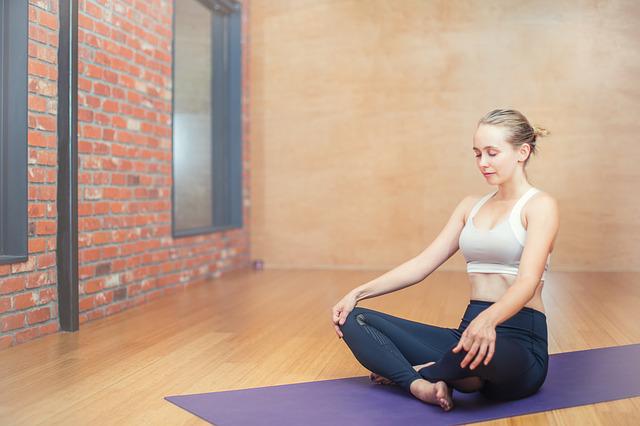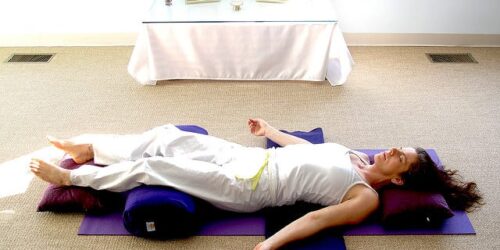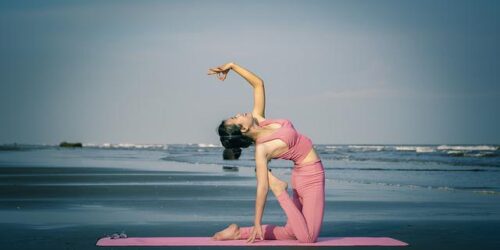How Long To Hold Yoga Pose? A Beginner’s Guide
First, how long to hold yoga pose?
If you’re doing yoga for strength and endurance elements, hold times will be more dependent on the difficulty of the pose. Generally speaking, you want to aim for hold times of 3–6 ten-second breaths, which equates to 30–60 seconds of hold time.
Why so many people are confused about a pose’s length is understandable: often yoga books, websites, and bloggers will simply show the pose (guilty!) and not share how long you should stay in the pose.
I’ll give you more specific instructions on how long to hold a yoga pose.
Table of Contents
How Long To Hold Yoga Poses For Freshman
Actually, there isn’t a set duration for holding poses in general. There are some guidelines that can give you an idea of how long you should try to hold each pose, but it varies greatly from person to person.
In general, you can anticipate holding yoga poses for anywhere from a few seconds (one or two breaths) to five minutes.
Yoga can be done in many different ways. Depending on how you feel on any given day, you can decide how long to hold a yoga pose. You might want to start your day off with a quick yoga routine on some days, holding each asana (posture) for just one breath.
Occasionally, you might want to maintain a pose for up to five minutes. This is typical of restorative yoga forms like Yin Yoga.
By paying close attention to your body and stopping each pose when you begin to feel discomfort or fatigue, you can best gauge how long to hold each yoga pose. Just keep in mind that the goal of this exercise is to relax by practicing yoga during the day, not to win a race.
How Long To Hold Yoga Poses: The Style Of Yoga
Depending on the type of yoga you practice, you should hold each pose for a specific amount of time to get the most benefit from your practice. Take these as suggestions for your practice; you can modify each style to suit your requirements.
Yin Yoga : 3 – 7 Minutes Per Pose
Typically lasting three to five minutes, yin yoga is based on holding poses for extended periods of time. The soft tissues in your body, such as ligaments and tendons, are the main focus of this technique rather than just the muscles. The duration of each pose allows you to go deeper into them and gives your body enough time to adapt. Passive stretching increases circulation and aids in releasing connective tissue adhesions.
Vinyasa Flow Yoga: 1 – 5 Breaths Per Pose
You must be able to maintain your focus and energy throughout the entire vinyasa flow class, which can last up to an hour depending on your level, because there won’t be much time for rest or repetition. Normally, only 1 to 5 breaths are held in each pose.
Ashtanga Yoga: 5 Breaths Per Pose
Every posture in Ashtanga yoga is held for approximately five breaths. It’s best to keep this number in mind if you’re just starting out with yoga because pushing yourself too hard into any stretch or pose that makes you uncomfortable could lead to injury.
Restorative Yoga: 5 – 20 Minutes
Make sure you can maintain poses without losing concentration or energy because a restorative class will give your body time to relax completely. Each pose should be held for anywhere between five and twenty minutes.
Power Yoga: 1 – 6 Breaths Per Pose
Power yoga might be the best style for you if you want to improve your strength, flexibility, and endurance. It’s important to avoid holding poses for too long when practicing this kind of yoga because doing so can lessen its advantages. Instead, concentrate on inhaling deeply throughout each pose to promote free flow of energy through the body and mind.
Bikram Yoga: 90 Seconds (or More) Per Pose
Given that the focus of hot yoga is on perfect form rather than speed or intensity, you’ll need plenty of time to hold each posture without feeling pain before moving on to the next one. If you want to increase your stamina and cardiovascular fitness, this style of yoga is perfect for you.
Hatha Yoga: 30 Seconds – 1-minute Per Pose
With this method, unless instructed otherwise by the instructor during a yoga session, you’ll hold each posture for anywhere from 30 seconds to about a minute before moving on to the next one with little to no rest periods in between. Although it might seem brief, regular use yields quick results, so be patient!
Iyengar Yoga: 5 – 30 Minutes Depending On The Yoga Pose
To make certain poses easier to complete, Iyengar yoga uses props like straps, blocks, and blankets. Yoga props allow poses to be held for longer, but fewer repetitions are usually performed to avoid overstretching or injury.
Sivananda Yoga: 1 – 3 Minutes Per Posture Depending On The Pose
This style of yoga emphasizes taking slow, deep breaths while performing each pose, making it useful if you’re looking for a more tranquil workout that’s great for before bed because it helps to improve sleep patterns!
There isn’t really a rule for how long poses should be held in general. While there are some general rules that can give you an idea of how long you should try to hold each pose for, it varies greatly from person to person.

Holding Yoga Poses A Long Time Benefits
Yoga poses can be held for longer periods of time with a variety of physical and mental advantages.
Benefits of maintaining poses for longer:
- Builds strength: Your muscles cooperate to keep you in certain yoga positions, such as Downward Facing Dog or Warrior 1. This causes minor tears in the muscles, and as it heals, it builds up, resulting in strong, lean muscles.
- creates balance and stability: The longer you can hold a pose while breathing, the more balanced and stable you become.
- allows you sufficient time to determine your body’s ideal alignment: When you hold a pose, you have time to construct the pose from the ground up, resulting in a practice that is easy.
- Gives time to explore the pose: Going deeper or going for a bind are both options. Holding a yoga pose for a prolonged period of time enables you to experiment with it, uncovering new sensations and difficult variations.
- Lengthens muscles: Your muscles and connective tissue start to slowly stretch out and lengthen when you hold poses like Seated Forward Fold or Reclined Pigeon. This gives you that long, lean appearance, but it also keeps your connective tissues happy, healthy, and functional.
- Creates flexibility: Yoga poses have a push-pull effect that lengthens and strengthens muscles. As we go about our regular, daily lives, this promotes flexibility and keeps your joints within a healthy range of motion, preventing injuries.
- Generates curiosity: You can really explore where your edge is and how far you can go when you can hold a pose for a longer period of time.
Holding Yoga Poses Briefly Benefits
Similar to holding for a longer period of time, holding a pose for 1-2 breaths has its own set of advantages. Once more, both mental and physical benefits are included in these advantages.
Benefits of briefly holding yoga poses:
- cardiovascular health is enhanced: After only a few breaths, you can start linking poses, which will raise your heart rate and benefit your cardiovascular health.
- Increases metabolism: Your body warms up and your metabolism gets going as you move quickly through a yoga sequence.
- Burns fat: Your body will begin to build muscle and burn fat when you alternate between poses.
- Increases stamina: You will start to be able to move for longer periods of time without getting tired as you practice flow and learn to link your breath to movement.
- Teaches you to enjoy the moment: You begin to appreciate the pose and become eager to return to it the next time when you’re in something for such a brief period of time.
Other Factors To Consider When Deciding Hold Times
How Hard Is The Pose?
The hold time is also impacted by the pose itself. No matter how strong you are, some poses are just incredibly challenging by nature and difficult to hold for long. For instance, maintaining a dolphin pose is significantly more difficult than a mountain pose.
You might only be able to hold dolphin for 20 seconds or two breaths if you’re exerting yourself to the fullest. You can likely remain in mountain pose for two to three minutes without perspiring.
Age Matters
Your hold times are heavily influenced by your age. Some poses can be very demanding and challenging if you haven’t been maintaining your strength and mobility. For instance, rushing into a one-legged balance might be too difficult, so holding it for a shorter period of time or using a wall for support is advised.
How Do You Feel Right Now, Mentally And Physically?
We aren’t made to perform laborious tasks repeatedly and endlessly like machines. Therefore, before working out, it’s crucial to ask yourself: “How am I feeling?”
Consider how your body is feeling, paying attention to any pain, achy joints, or sore muscles. Perhaps you exerted a lot of effort yesterday but still desire to exercise today.
Every workout doesn’t have to be an intense, perspiration-filled struggle. To step back and be gentle with yourself is totally acceptable. An enormous accomplishment in and of itself is simply getting up and exercising.
It’s acceptable to hold poses for shorter periods of time if you’re feeling exhausted, uninspired, or even sluggish, though. Maybe all you need is three breaths in a pose. Always keep in mind that even modest achievements count. Even a quick routine with quick holds benefits your body and mind more than just lounging around.
Which Fitness Level Do You Have?
Hold times also heavily rely on your current physical capabilities. Your capacity to hold difficult poses will differ significantly from that of someone who has been training consistently if you have never really exercised or haven’t in a long time.
This doesn’t imply that you’re not improving or that your yoga skills are lacking. Everyone has a starting point, and it’s the journey rather than the destination that counts. I’d say you’re doing great as long as you feel like you’re improving in terms of strength, flexibility, mobility, and ultimately confidence.
Conclusion
The duration of a yoga pose was the main topic of the article.
Depending on your goals, physical restrictions, and the type of yoga you’re practicing, the length of time you should hold a pose will vary. But no matter how long you hold a pose, you should strive for proper body alignment and posture to prevent any injuries.
As a warm-up or to give you an energy boost, keep in mind that short hold times are fantastic. Longer hold times, on the other hand, can be applied to either strength training or recovery exercises.
Many thanks for reading.





